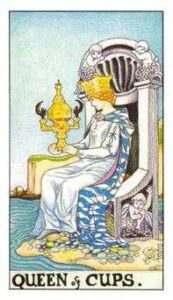 I’d like to tell you about a particularly potent form of inner work that helped my daughter achieve her career goals. Julie was at Florida State University (Go Noles!) working on her Ph.D. in Marriage and Family Therapy when the time came to write her dissertation. Suddenly, the psychic energy that had served her so well for so long hit a wall. The challenge before her seemed so daunting that she became immersed in a dark swamp of inertia. No matter how hard she tried, she just couldn’t get started and it seemed as if she might never bring closure to years of hard work.
I’d like to tell you about a particularly potent form of inner work that helped my daughter achieve her career goals. Julie was at Florida State University (Go Noles!) working on her Ph.D. in Marriage and Family Therapy when the time came to write her dissertation. Suddenly, the psychic energy that had served her so well for so long hit a wall. The challenge before her seemed so daunting that she became immersed in a dark swamp of inertia. No matter how hard she tried, she just couldn’t get started and it seemed as if she might never bring closure to years of hard work.
Overcoming our natural resistance to undertaking and carrying out difficult tasks requiring months or years of concentrated and directed effort is, in the words of Jungian analyst M. Esther Harding, “a positive factor leading to self-discipline and culture, and on its development civilization largely depends.” Having struggled with the same challenge in my own doctoral studies, I knew what Julie was going through and offered to help.
A process I had used successfully to understand and address the needs of both sides of my own internal conflicts is called the Voice Dialogue. Psychologists Hal and Sidra Stone developed this method and describe it thusly: “In using Voice Dialogue, we directly engage these subpersonalities or voices in a dialogue without the interference of a critical, embarrassed, or repressive protector/controller….The ego occupies a central physical space, and the subpersonalities play out their conflicts around it.”
Julie and I realized that the subpersonalities involved in her dilemma were her Innocent Child who wanted to relax and play instead of taking on adult responsibilities, and her Warrior who would be deeply ashamed if he didn’t fulfill his goals. Julie found two images to represent these warring energies. For her Innocent Child she chose her childhood doll, Dudgie. For her Warrior she chose a ceramic statue of a crouching black panther. She herself, of course, represented her ego.
Laying out four cushions on her living room floor we took our seats. I sat opposite Julie, and Dudgie and the panther faced each the other from the remaining two cushions. After lighting a candle to designate this as sacred work in a sacred place, Julie began by describing the problem. Then, moving to Dudgie’s cushion, she held her doll in her lap while giving voice to the youthful wishes and needs she represented. Next, Julie occupied her panther’s space and repeated the process from his perspective.
After Julie returned to her own cushion and summarized what she had learned we formulated a compromise to meet the needs of her inner adversaries. The solution to which all agreed was that if Innocent Child would let Warrior work for a certain number of hours every weekday without complaint, he would let her relax, play, eat her favorite foods, and watch her favorite TV shows on weekends and evenings when she wasn’t in class without laying a guilt trip on her. They also decided it might help if Julie checked in with me each week for encouragement and support.
The results of this creative work were immediate and dramatic. Something in that process opened up a dam and released enormous energy. Within a few months Julie completed and submitted her dissertation. A few months later, an empowered and very happy Dr. Julie embarked on her new career. Is this amazing or what? It’s a simple fact that each of us contains all the transforming power we need, and we can activate it by reaching across the sacred divide and befriending the otherness within.

Living in a Culture That’s Lost Its Heart
“To learn how to fully live Eros makes a major contribution to the world around me, because this is a culture that’s lost its heart;



0 Responses
Hi Jean,
The thing that strikes me the most about this post, aside from the wonderful insights you both gleaned from the process you shared, is the fact that you and your daughter engaged in the process together at all. I was deeply moved and impressed that your daughter trusts you enough to open up the way she did. I was also touched that you were able to create such a safe and sacred space with such love and care for your own child. It is a testament to the strength and wisdom of both of you. It is also an inspiration to parents everywhere, especially this one. You are both very blessed. Cheers and thanks.
I’m a very lucky woman, Joseph. My mother trusted me without reservation, I trusted my children the same way. It’s just the way of life that treating children with utmost respect for their individual rights and uniqueness benefits everyone. Thank you. Jeanie
Sent from my iPhone
It seems I fell upon a technique that worked similarly, Jeanie. I was putting a group of stories into book form but I was having a difficult time ordering the stories, creating flow from one to the next. I decided I would use an imaginary character that I’d meet at McSorley’s stove every so often and we’d discuss the lessons I’d gleaned from the prior story. Next, the character would hint at or suggest a new story.
To my amazement, as I started writing these dialogues, and speaking them aloud as I wrote, I found that I was really in a discussion with myself, exploring my deepest thoughts and motivations, and uncovering insights into myself that I hadn’t expected.
I’ve read that writers of fiction often experience this. By stepping outside of themselves, through an imaginary character, they somehow create a place where they can examine themselves in ways that they theretofore had been incapable of doing. I suppose you might say, “They found a way to get out of their own way.” Further, I find that the sound of my voice impacts me in a way that reading silently can’t. The combination of visual and sound seems to have a compounding effect. (We’ve talked about this.)
Very thought provoking post, Jeanie. Once again you put the intellectual stylings on something that I fell upon accidentally…well, maybe intuitively.
Charlie
Very cool! The characters we imagine are part
of us…..,because it is WE who are imagining them. Anything we can imagine is part of us; which is why creative forms of inner work are so powerful. Engaging our imagination and intuition is a direct route to our unknown, unintegrated selves. Logos-oriented people tend to say, “Oh, that’s just your imagination,” dismissively, but in doing so add another brick to the wall that separates them from their whole selves, as if thinking factually is the only way to think. Thank goodness Einstein didn’t build arbitrary boundaries around his intelligence!
Thanks for sharing your fascinating writing technique. Mine is similar. I untangle knotty thoughts by imagining I’m trying to explain something to a waking life friend. It just happens naturally, without conscious intention, and always unsticks my thinking.
My best,
Jeanie
Jeanie,
This was a very timely post for me. I am going to use this process to work on my own writing inertia.
Thanks for the tip and the great imagery!
Jenna
You’re so welcome. I hope you’ll let me know how it works for you!
Jeanie
Jean Benedict Raffa, Ed.D. Email: jeanraffa@aol.com Blog: http://jeanraffa.wordpress.com/ Web: http://www.jeanraffa.com Facebook: http://www.facebook.com/jeanraffa
What a great exercise to share. We all have some conflicting emotions inside of us, and how to get them to work in harmony is always the journey.
Thanks, Donna. It is, indeed!
Jeanie
Jean Benedict Raffa, Ed.D. Email: jeanraffa@aol.com Blog: http://jeanraffa.wordpress.com/ Web: http://www.jeanraffa.com Facebook: http://www.facebook.com/jeanraffa